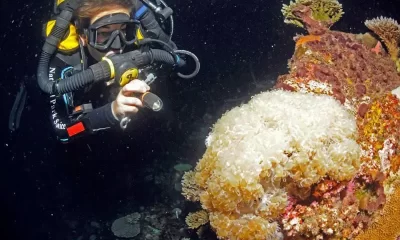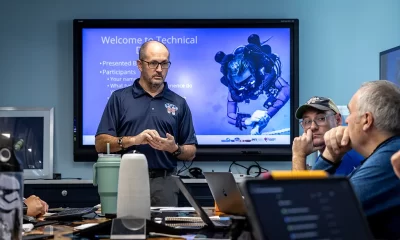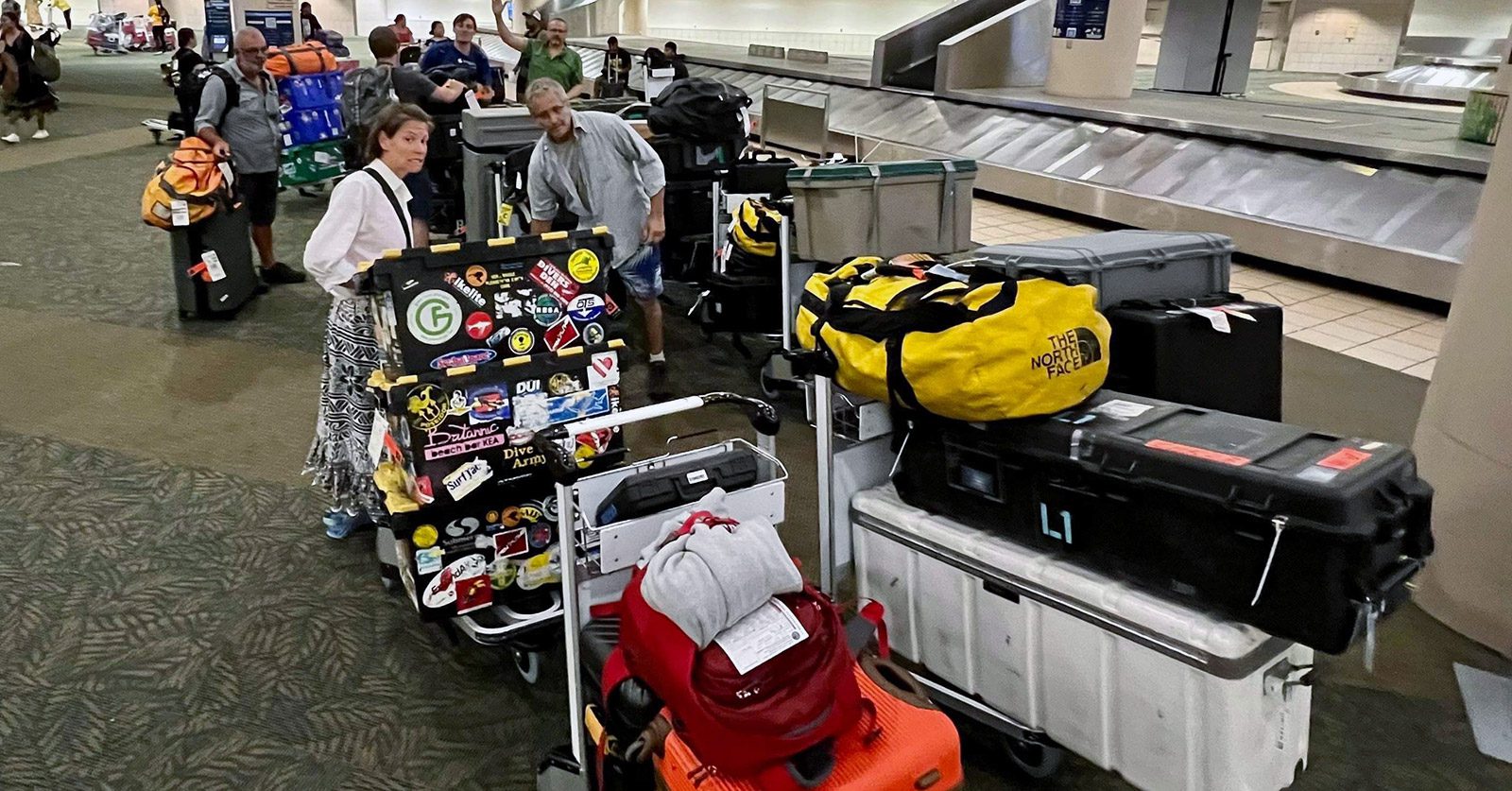
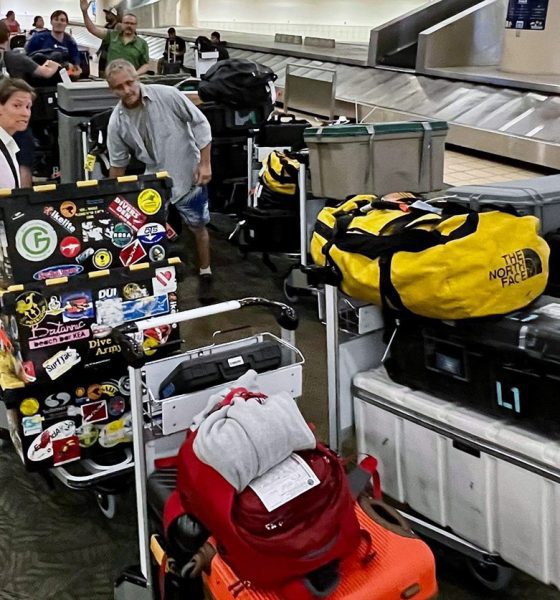
Community
Have Breather, Will Travel – Tips from the Pros
As hundreds of rebreather professionals prepare to head to Malta for the three-day industry and scientific symposium, Rebreather Forum 4, we thought it timely to offer some tips from the experts on traveling with your rebreather. InDEPTH managing editor Ashley Stewart talks to the pros and explains what you need to know and what’s consider best practices. So, break out your breather and start packing.
By Ashley Stewart. Header image: Explorers Pete Mesley, Richie Kohler and three other CCR divers sporting 51 cases and bags of equipment in route to conduct a recent Defense POW/MIA Accounting Agency (DPAA) project in Micronesia. Photo courtesy of Richie Kohler.
🎶 Pre-dive clicklist: Coming Into Los Angeles by Arlo Guthrie 🎶
Traveling with a closed circuit rebreather is not a straightforward task. Just like traveling for open-circuit diving, you’ll need to find a destination that supports what you have in mind, figure out which pieces of equipment you need to bring, how to transport them safely, what you can rent or borrow at your destination.
Except now the diving and equipment is more complex, and the stakes are higher if you lose, break, or forget anything because you’re less likely to be able to track down a replacement, not to mention having problem with airport and custom agents. CCR travel takes far more advanced planning.
Whether you’re a new rebreather diver traveling with your unit for the first time, or a practiced CCR traveler telling yourself there’s got to be a better way, you may be asking: What are the important considerations for a diving destination? What luggage should I use? What do I check and what do I carry on? What spares do I need to bring?
As hundreds of rebreather professionals head to Malta for the industry conference Rebreather Forum 4, InDEPTH asked expert CCR travelers about the basics.
Start With Your Destination


One of the biggest considerations for rebreather travel is finding a dive shop capable of supporting CCR-length bottom times, exposures, and equipment, said Graham Blackmore, an instructor evaluator who teaches Global Underwater Explorers (GUE) capstone rebreather class.
Select your destination keeping in mind the unique equipment needs of your CCR—and be adaptable.

“Something I always tell newer CCR divers is that you need to learn to be flexible,” Emmy-winning underwater photographer and CCR instructor Becky Kagan Schott said. “Ask the destination site what they have and confirm it. If they have only a certain size tank, you may have to make adjustments. If they don’t have the valve you, need you should bring valves.”
One consideration is carbon dioxide absorbent, or sorb. Sofnolime, the most commonly used sorb, is often difficult to acquire at many destinations. You may find you have to travel with your own sorb, in which case renowned cave explorer, filmmaker, author and instructor Jill Heinerth recommends attaching a Material Safety Data Sheet to the container. Check airlines for specific regulations regarding sorb.
Confirm the destination not only has the tanks you need, but the valves. Lola-style manifolds, like those used in the GUE configuration of the JJ-CCR, can be hard to find, and you may have to bring your own. AL40s are typically easy to track down, but be aware these may have different neck threads than in your home country.
Renting the rack or frame of a CCR is worth asking about to save some baggage space, but traveling with your own is generally straightforward and doesn’t add too much weight, experts agreed.
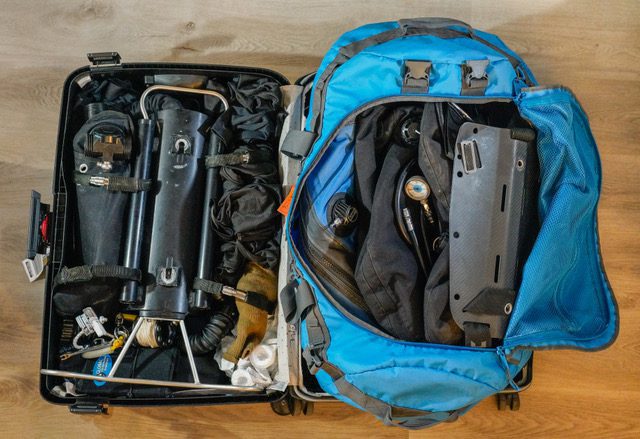
Which luggage is best?
Now you know what you’re bringing. To which luggage should you trust your CCR? Just like everything in CCR travel, the answer depends on the unit. Some units—like Dive Rite’s 7.7kg /17 lbs Optima Chestmount aka the CHO2PTIMA, which is able to fit in a small carry-on roller case—are intended for easy travel.
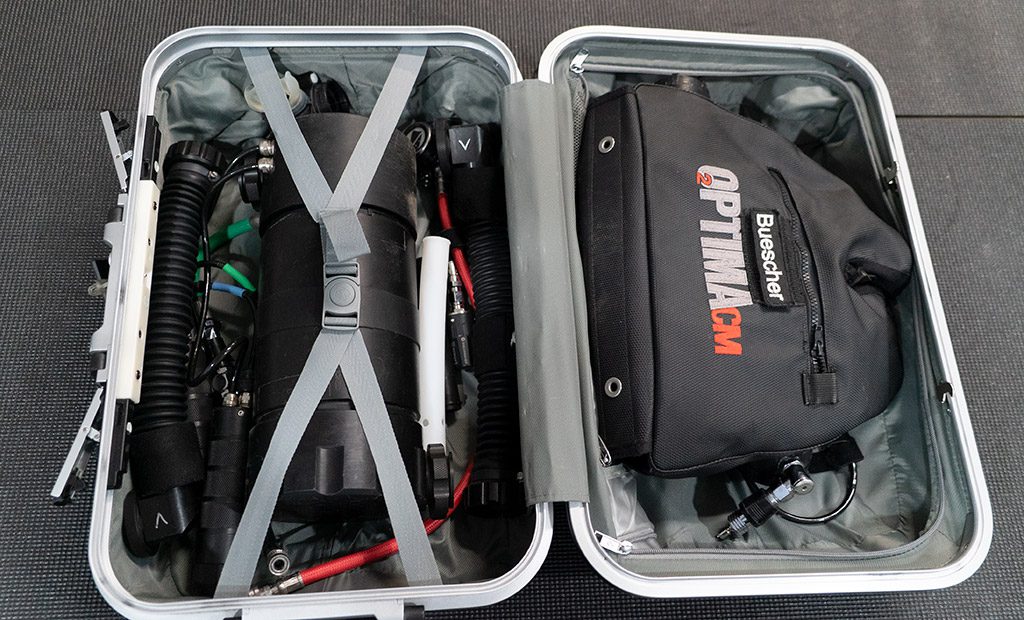
Schott’s Megalodon CCR, for example, weighs 38 pounds and is designed to fit in carry-on luggage. For others, the consensus among most experts polled by InDEPTH was to use a hardshell suitcase instead of a Pelican case.
Most of the experts agreed Pelican cases are unnecessarily heavy and expensive, aren’t built to go into cars and vans such as taxis in remote destinations, and attract unwanted attention. “It looks like something important and expensive is inside, and this can make it a target for thieves,” Blackmore said.
If you aren’t scared away by excess baggage fees or a perceived higher risk of theft, stick with the Pelican Air. Schott—who travels with her Divesoft Liberty Sidemount unit in a Pelican Air case—tries to keep it inconspicuous. “I prefer something that won’t draw too much attention,” she said. “I don’t put fragile or stickers on the case to indicate what’s in it.“
Fathom Dive Systems founder Charlie Roberson packs his entire rebreather, plus spares and travel tools, in a Pelican Air 1615 with a Trek Pak divider at just under 50 pounds. “I’ve travelled to Palau, California, Bonaire, and Mexico many times without any damage or loss,” Roberson said. “The Pelican case, which has wheels, is so easy to handle I’m considering replacing my XL North Face duffel with another for the rest of my gear.”
“Anything with wheels is going to work if the frame fits inside,” instructor evaluator and CCR instructor Guy Shockey said, who noted the Pelican Air 1607 as an option.
Spares

Pete Mesley—who teaches rebreathers and runs CCR trips through his company Lust4Rust—suggests bringing “anything that will save your trip if you lost it or broke it.”
The experts generally agreed the most important spares to bring when traveling with a CCR are spare cell, tear aid (or spare counterlungs), batteries, and O-rings.
Schott likes to dive with others on similar units and brings spares as a group. In addition to the basics above, Schott brings service tools for her bailout-valve, a manual add valve, a spare handset and heads-up display (HUD).
Shockey decides what to bring based on how remote the destination is. “I usually carry a full set of tools and spare parts as per the document in GUE materials,” Shockey said. He brings exact size wrenches and Torx and Allen wrenches rather than full kits to save room, plus spare overpressure valves for first-stages.
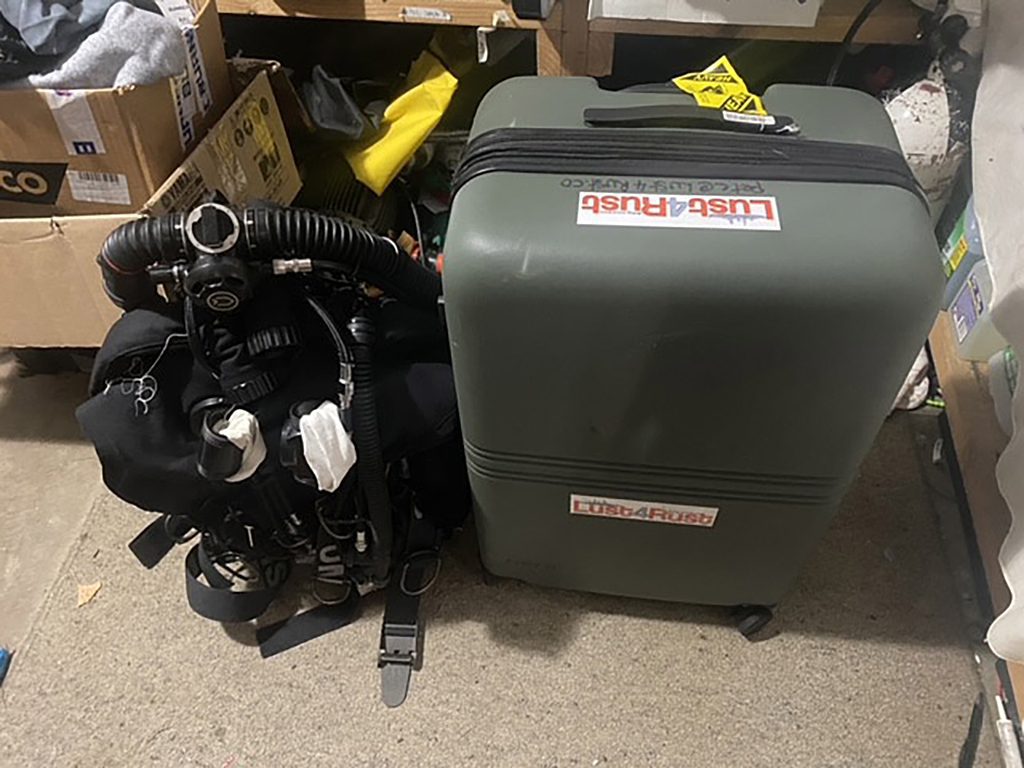
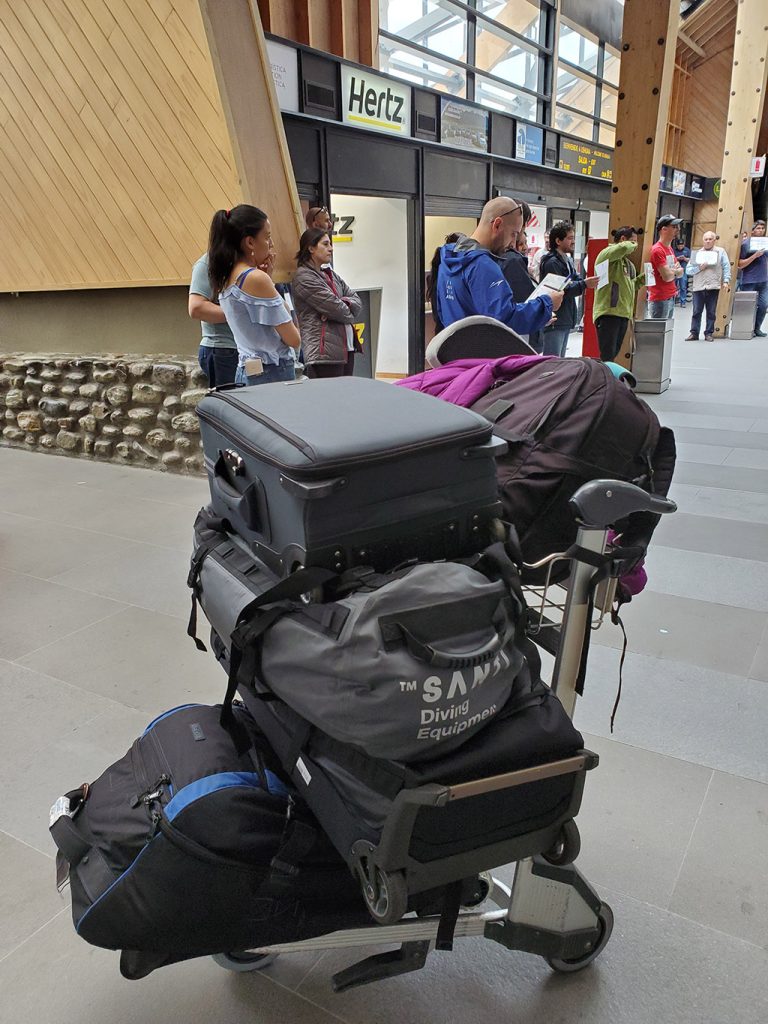
To Check Or Not To Check
The biggest travel-related debate among CCR divers appears to be what to check and what to carry on, which, like all considerations, depends on the type of rebreather.
“I always check my breather, as I have so much expensive camera gear that needs to go carry-on,” Heinerth said. “Honestly, rebreathers are robust if packed well—especially a JJ.”

Cave explorer and CCR instructor Kirill Egorov brings the head of his JJ-CCR, the most important and expensive component, in his carry on. He packs the unit by removing the stand and handle from the canister so it will fit in any bag, and checks it along with the scrubber, regulators, and counterlungs with the T-pieces—fittings that connect the loop and counterlungs—removed.
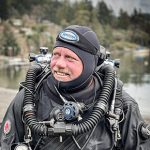
Shockey carries on the head, counterlungs, and loop. “I have opened several brand new JJ’s in their original shipping and found holes in the counter lung,” he said. He also occasionally removes the stand after seeing a few break the Delrin base on the actual canister when it dropped (a $250 replacement). Shockey also suggests taking the head out of carry-on luggage through security because it shows up as a black blob on the X-ray machine. “Easier to calm them down at the beginning than trying to do damage control,” he said.
Mesley travels with his assembled JJ-CCR unit in checked baggage and said he’s never damaged his gear despite averaging as many as 50 flights with his rebreather this way prior to the pandemic. “When I travel, I keep the unit as fully intact as possible,” Mesley said, with the exception of removing the mouthpiece/bailout valve hose assembly and packing the T-pieces with soft material. The idea is to prevent the counterlungs from being punctured or crushed by the T-pieces.
Blackmore checks his JJ-CCR with the head attached to the canister.
“It is important to hold the shape of the canister,” Blackmore said. “It’s very easy to bend the canister without the head in place.”
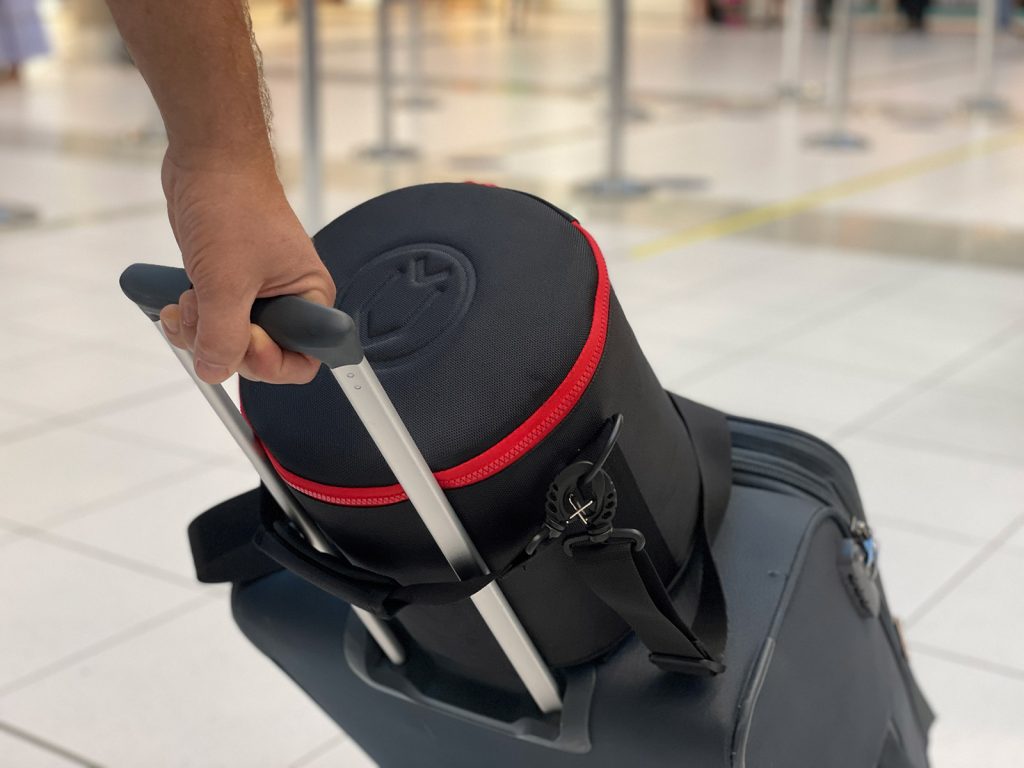
Educate Customs Agents
Regardless of what luggage you use or in which part of the plane your rebreather travels, you’ll have to contend with Customs agents who have likely never come across such a machine. You may want to consider leaving information for Customs agents to expedite immigration checks.
Heinerth and Schott both include a laminated sheet in baggage explaining a rebreather. Heinerth’s letter is attached below. She also includes a page in large font stating, “Fragile. Life Support. Safe for Airline Transport,” and handwrites a note to the Customs agent with her seat number and phone number.
Schott includes similar notes in her CCR and camera bags. The note indicates the unit is rebreather used for scuba diving, and that it is life-support equipment. She also includes a photo of what the unit looks like assembled and a phone number and email address. Divesoft offers a similar “Liberty Passport” PDF for its users.
The Bottom Line
Experts agreed the keys to successfully traveling with your CCR are to start planning long in advance to arrange what you need, be flexible, and prepare to pay up for excess baggage to ensure you have what you need for the trip.
“When you travel to these amazing destinations, the cheapest part of this whole trip will be the excess baggage charges, so just focus on what you need to take, pack it up safely, weigh it beforehand and pre-plan your excess bill,” Mesley said. “Then you dive with what you are comfortable with, your holiday is fun and, if you have a few issues with your gear, you have the parts to repair it, and get back to your diving.”
DIVE DEEPER
Into the Planet: CCR Notice to Border Personnel
Into The Planet: More Tips for Traveling with Rebreathers
Becky Kagan Schott: Traveling With A Megalodon
Becky Kagan Schott: Traveling with Liberty Sidemount
Divesoft: How To Travel With A Rebreather
Divesoft: Liberty Passport (CCR travel papers)

InDepth Managing Editor Ashley Stewart is a Seattle-based journalist and tech diver. Ashley started diving with Global Underwater Explorers and writing for InDepth in 2021. She is a GUE Tech 2 and CCR1 diver and on her way to becoming an instructor. In her day job, Ashley is an investigative journalist reporting on technology companies. She can be reached at: [email protected]

























